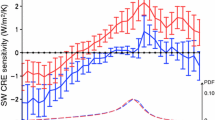Summary
Broad scale vertical velocities have been used to predict the development over southern Australia of cloud associated with cold fronts. The vertical velocities were determined by solving explicity the quasi-geostrophic omega equation expressed in terms ofQ-vectors. The frontal cloud band was located within the are where up-motion was diagnosed, with the deepest cloud in the vicinity of the strongest upward velocities, and the rear of the band coinciding closely with the change from up- to down-motion. On those occasions when a major cloud mass evolved the region of up-motion extended to low latitudes as a clearly defined band. This band was indicative free a well developed warm conveyor belt associated with the frontal system. Areas of diagnosed down-motion were free of deep, organised cloud masses. Stronger upward motion did not produce an immediate increase in the cloudiness; typically there was a delay of 12 to 24 h before the corresponding cloud development became apparent.
Similar content being viewed by others
References
Barnes, S. L., 1985: Omega diagnostics as a supplement to LFM/MOS guidance in weakly forced convective situations.Mon. Wea. Rev.,113, 2122–2141.
Barnes, S. L., 1986: On the accuracy of omega diagnostic computations.Mon. Wea. Rev.,114, 1664–1680.
Doswell, C. A., III, 1987: The distinction between large-scale and mesoscale contribution to severe convection: a case study example.Weather and Forecasting,2, 3–16.
Guymer, L. B., 1978: Operational application of satellite imagery to synoptic analysis in the Southern Hemisphere. Tech. Rep. 29, Bur. Meteor., Australia, 83 p. (Bureau of Meteorology, GPO Box 1289 K, Melbourne, 3001, Australia).
Hanstrum, B. N., Wilson, K. J., Barrell, S. L., 1989a: Prefrontal troughs over southern Australia. I: a climatology. Submitted toWeather and Forecasting for publication.
Hanstrum, B. N., Wilson, K. J., Barrell, S. L., 1989b: Prefrontal troughs over southern Australia. II: a case study of frontogenesis. Submitted toWeather and Forecasting for publication.
Harrold, T. W., 1973: Mechanisms influencing the distribution of precipitation within baroclinic disturbances.Quart. J. Roy. Meteor. Soc.,99, 232–251.
Holton, J. R., 1972: An Introduction to Dynamic Meteorology. New York: Academic Press, 319 pp.
Hoskins, B. J., Draghici, I., Davies, H. C., 1978: A new look at the ω-equation.Quart. J. Roy. Meteor. Soc.,104, 31–38.
Hoskins, B. J., Pedder, M. A., 1980: The diagnosis of middle latitude synoptic development.Quart. J. Roy. Meteor. Soc.,106, 707–719.
Kelly, G. A., Forgan, B. W., Powers, P. E., LeMarshall, J. F., Hassett, M., O'Connor, B., 1983: A satellite-based operational system for upper air analysis in the Australian region.Rem. Sens. Envir.,13, 369–390.
Kuo, Y.-H., Skumanich, M., Haagenson, P. L., Chang, J. S., 1985: The accuracy of trajectory models as revealed by the Observing System Simulation Experiments.Mon. Wea. Rev.,113, 1852–1867.
Leslie, L. M., Mills, G. A., Logan, L. W., Gauntlett, D. J., Kelly, G. A., Manton, M. J., McGregor, J. L., Sardie, J. M., 1985: A high resolution primitive equations NWP model for operations and research.Aust. Meteor. Mag.,33, 11–36.
McGregor, J. L., Leslie, L. M., Gauntlett, D. J., 1978: The ANMRC limited-area model: consolidated formulation and operational results.Mon. Wea. Rev.,106, 427–438.
Mills, G. A., 1989: The dynamics of a rapid cloud band development over southeastern Australia.Mon. Wea. Rev. (in press).
Mills, G. A., Leslie, L. M., 1985: The use of NWP model output in the prediction of significant weather events.Aust. Meteor. Mag.,33, 167–180.
Ryan, B. F., Wilson, K. J., Garratt, J. R., Smith, R. K., 1985: The Cold Fronts Research Programme: Progress, future plans and research directions.Bull. Amer. Meteor. Soc.,66, 1116–1122.
Ryan, B. F., Wilson, K. J., 1985: The Australian summertime cool change. Part III: Subsynoptic and mesoscale mode.Mon. Wea. Rev.,113, 224–240.
Seaman, R. S., 1969: Experiments with the omega equation in the Australian region.Aust. Meteor. Mag.,17, 177–197.
Seaman, R. S., Falconer, R. L., Brown, J., 1977: Application of a variational blending technique to numerical analysis in the Australian region.Aust. Meteor. Mag.,25, 3–23.
Tapp, R. G., 1988: Vertical motion diagnostics related to Q-vectors, and the reorganisation of a cold frontal system.Meteorol. Atmos. Phys.,39, 65–73.
Wilson, K. J., Ryan, B. F., 1987: The role of low-level cooling in a conceptual model of the Australian summertime cool change: implications for very-short-range forecasting. Proc. Symp. Mesoscale Analysis and Forecasting, Vancouver, Canada, 17–19 August 1987, ESA SP-282, 213–218.
Wilson, K. J., Stern, H., 1985: The Australian summertime cool change. Part I: Synoptic and subsynoptic scale aspects.Mon. Wea. Rev.,113, 177–201.
Author information
Authors and Affiliations
Additional information
With 10 Figures
Rights and permissions
About this article
Cite this article
Tapp, R.G., Oliver, S.E. Diagnosis and prediction of middle level cloud development associated with cold fronts over southern Australia. Meteorl. Atmos. Phys. 41, 231–246 (1989). https://doi.org/10.1007/BF01026112
Received:
Issue Date:
DOI: https://doi.org/10.1007/BF01026112




